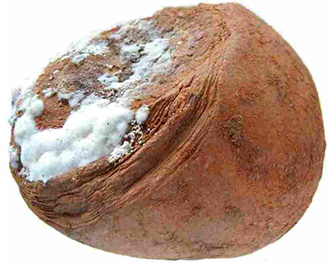Please click here to access the main AHDB website and other sectors.
- Home
- Knowledge library
- Dry rot
Dry rot

Dry rot is the most important fungal rot of potatoes affecting around 1 % of tubers in Great Britain. It is mainly caused by a group of four Fusarium species, particularly in warm, sandy soils.
Symptoms
There are several different species of Fusariumwith slightly different symptoms but generally dry rots develop around an initial wound dehydrating in concentric wrinkles and with obvious white fluffy, mycelial growth.
Internally there may be brown rotting and cavitation with more white mycelial growth. F. coeruleum is the most common dry rot and may have some blue external mould and inside an indistinct margin. F. sulphureum gives a more pronounced and sharper edged cavity, which externally may be confused with gangrene (Phoma spp.). F. avenaceum has a dark brown rot and F. culmorum is dry, dark brown and with a well defined margin, sometimes resembling tunnels in cross-section.
Conditions
The pathogen may be seed or soil born but the key issue is tuber damage, dry rot would not develop without an initial wound. Infection occurs during harvesting and handling (grading) and is favoured by warm weather. Rots develop in store and are more likely to be seen after the turn of the year. Its true impact is often masked by secondary bacterial soft rotting.
Control
As disease pressure is high an integrated approach to dry rot control is appropriate. Check potential field sites for disease history, volunteer problems and any alternative crop hosts in rotation. Maintain long rotations of 7 years or more and where possible choose resistant varieties, see the Potato Variety Database for more information. Minimise crop stress and promote full skin set by leaving an interval between haulm destruction and harvest. Minimise handling damage and adequately cure any wounding before storage. Fungicides are available but treat early and be aware of resistance issues.

